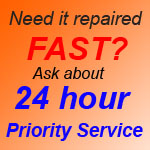
REPAIR SERVICES:
BLOG
RATES
ABOUT US
CONTACT US
INDUSTRIES SERVED
- Drives
- Servo
- Spindle
- Soft Start
- Vector
- Inverter
- DC
- Stepper
Drives and Motor Controllers A motor controller is a device or group of devices that serves to govern, in a predetermined manner, the performance of an electric motor. A motor controller may include a manual or automatic means for starting and stopping the motor, selecting forward or reverse rotation, selecting and regulating the speed, regulating or limiting the torque, and protecting against overloads and faults. Every electric motor must have some kind of controller. The motor controller will have differing features and complexity depending on the task the motor will be performing. Select one of the tabs above to learn more about your particular drive technology. |
Servo Drive A servo drive is a special electronic amplifier used to power electric servo motors. It monitors feedback signals from the motor and continually adjusts for deviation from expected behavior. Function
Alternate names for Servo drives could be: Brushless Servo Drive, AC Servo Drive, DC Servo Drive, Amp Drive, Amplifier, Linear Electrical Servo Drive, Hydraulic Servo Drive, Analog Servo Drive, Digital Servo Drive, Trapezoidal Servo Drive, Sinusoidal Servo Drive, AC Feedback Drive REA Technologies is an expert in servo drive repair. Below is a list of Servo Drive manufacturers that we are familiar with. If yours is not listed, please call us, we will be able to help you. |
Spindle Drives Spindle Drives are highly reliable AC vector controlled inverter drives. These drives are designed for controlling high speed, and compact AC motors used in machine tool spindle drive applications. Machine tool spindle drives require one of the most demanding motion solutions. Repairing damaged spindle drives is one of REA Technologies' specialties. Some other names for Spindle drives are Asynchronous Spindle Drive, Synchronous Spindle Drive, AC Spindle Drive, DC Spindle Drive, Brushless Spindle Drive, Torque Drive REA Technologies is an expert in spindle drive repair. Below is a list of Spindle Drive manufacturers that we are familiar with. If yours is not listed, please call us, we will be able to help you. |
Soft Start Drives A motor soft starter is a device used with AC electric motors to temporarily reduce the load and torque in the powertrain of the motor during startup. This reduces the mechanical stress on the motor and shaft, as well as the electrodynamic stresses on the attached power cables and electrical distribution network. A soft start drive can extend the lifespan of the motor system. Below is a list of Soft Start Drive manufacturers that we are familiar with. If yours is not listed, please call us, we will be able to help you. |
Vector Drives Phase vector drives (or simply vector drives) are an improvement over variable frequency drives (VFDs) in that they separate the calculations of magnetizing current and torque generating current. These quantities are represented by phase vectors and are combined to produce the driving phase vector which in turn is decomposed into the driving components of the output stage. These calculations require a fast microprocessor, typically a DSP device.
In some configurations, a vector drive may be able to generate full rated motor torque at zero speed. Some alternate names for vector drives include: AC Vector Drive, DC Vector Drive, Open Loop Vector Drive, Closed Loop Vector Drive, Sensorless Vector Drive REA Technologies is an expert in vector drive repair. Below is a list of Vector Drive manufacturers that we are familiar with. If yours is not listed, please call us, we will be able to help you. |
| BALDOR |
| BALDOR MOTION PRODUCTS |
| CONTROL TECHNIQUES |
| EMERSON |
| EMERSON PROCESS MANAGEMENT |
| INDRAMAT |
| KLOCKNER MOELLER |
| MOELLER ELECTRIC |
| MITSUBISHI |
| POWER ELECTRONICS |
| REXROTH INDRAMAT |
| UNIDRIVE |
| WER INDUSTRIAL |
Inverter Drives An inverter is an electrical device that converts direct current (DC) to alternating current (AC). The converted AC can be at any required voltage and frequency with the use of appropriate transformers, switching, and control circuits. Solid-state inverters have no moving parts and are used in a wide range of applications, from small switching power supplies in computers, to large electric utility high-voltage direct current applications that transport bulk power. Inverters are commonly used to supply AC power from DC sources such as solar panels or batteries. The inverter performs the opposite function of a rectifier. Some common alternate names for Inverters are: Variable Frequency Drive (VFD), Adjustable Frequency Drive (AFD), Variable Voltage Variable Frequency Drive (VVVFD), Single Phase Variable Frequency Drive, Frequency Drive, AC Drive, Variable Speed Drive (VSD), Adjustable Speed Drive (ASD), Synchronous Drive, Asynchronous Drive, Continously Variable Transmission Drive (CVT), Eddy Current Drive, Regenerative Variable Frequency Drive, AC Induction Drive, AC Pole Number Control Drive REA Technologies is an expert in Inverter drive repair. Below is a list of Soft Start Drive manufacturers that we are familiar with. If yours is not listed, please call us, we will be able to help you. |
DC Drives A DC drive is a motor control unit that controls a DC motor. DC drives consist of an SCR (Silicon Controlled Rectifier) bridge, which converts incoming three or single-phase AC volts to DC volts. Using this conversion process, DC drives can regulate speed, torque, voltage and current conditions of the DC motor. This is ideal for industrial processes such as tube mills, extruders, mixers, paper machines and various other controlled applications. Some common alternate names for DC Drives are: Brushless DC Drive, Linear Drive, DC Servo Drive, PWM Drive, BEMF Drive, Voltage Control Drive, 3 Phase DC Drive, Analog DC Drive, Digital DC Drive Below is a list of DC Drive manufacturers that we are familiar with. If yours is not listed, please call us, we will be able to help you. |
Stepper Drives A Stepper drive is a special type of motor controller that contains feedback technology to allow it to control the discrete movement of a Stepper Motor. Some alternate names for Stepper Drives include: Stepper Motor Drive, Half Step Drive, Bipolar Stepper Drive, Unipolar Stepper Drive, Micro-stepping Drive REA Technologies is an expert in stepper drive repair. Below is a list of Stepper Drive manufacturers that we are familiar with. If yours is not listed, please call us, we will be able to help you. |
All Rights Reserved, REA Technologies, Inc. 2551 US Hwy 70, Connelly Springs, NC 28612 (828) 397-6050
The designated brand names and trademarks described on this website are the property of their respective owners.
reatechtracking1


Over
83463
Items Repaired
Since 1991
Online Payments

